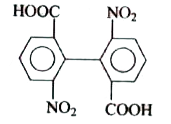Which of the following would exhibit cis-trans isomerism?
CH3CH2CH=CH2
ClCH=CHCl
ClCH=CCl2
CH2=CH−COOH
The correct Answer is:B
To determine which of the given compounds exhibit cis-trans isomerism, we need to follow these steps:
Step 1: Understand the Criteria for Cis-Trans Isomerism
Cis-trans isomerism (also known as geometric isomerism) occurs in alkenes where there is restricted rotation around a double bond. For a compound to exhibit cis-trans isomerism, it must have:
- A carbon-carbon double bond (C=C).
- Two different substituents on each carbon of the double bond.
Step 2: Analyze Each Compound
We will analyze the given compounds one by one to check if they meet the criteria for cis-trans isomerism.
1. Compound 1: CH3-CH=CH2
- Structure: CH3-CH=CH2
- On the double bond (C=C), we have CH3 and H on one carbon, and H and CH2 on the other carbon.
- Since there are identical substituents (two H atoms), this compound does not exhibit cis-trans isomerism.
2. Compound 2: Cl-CH=CH-Cl
- Structure: Cl-CH=CH-Cl
- On the double bond, we have Cl and H on one carbon, and Cl and H on the other carbon.
- Since both carbons have identical substituents (two Cl atoms), this compound does not exhibit cis-trans isomerism.
3. Compound 3: CH2=CH-COOH
- Structure: CH2=CH-COOH
- On the double bond, we have H and COOH on one carbon, and H and H on the other carbon.
- Since one carbon has two identical substituents (two H atoms), this compound does not exhibit cis-trans isomerism.
Step 3: Conclusion
After analyzing all the compounds, we find that none of the given compounds exhibit cis-trans isomerism because they either have identical substituents on one of the carbons of the double bond or do not have the required different substituents.
Final Answer
None of the compounds listed exhibit cis-trans isomerism.
---
Cis-trans isomerism (also known as geometric isomerism) occurs in alkenes where there is restricted rotation around a double bond. For a compound to exhibit cis-trans isomerism, it must have:
- A carbon-carbon double bond (C=C).
- Two different substituents on each carbon of the double bond.
We will analyze the given compounds one by one to check if they meet the criteria for cis-trans isomerism.
- Structure: CH3-CH=CH2
- On the double bond (C=C), we have CH3 and H on one carbon, and H and CH2 on the other carbon.
- Since there are identical substituents (two H atoms), this compound does not exhibit cis-trans isomerism.
- Structure: Cl-CH=CH-Cl
- On the double bond, we have Cl and H on one carbon, and Cl and H on the other carbon.
- Since both carbons have identical substituents (two Cl atoms), this compound does not exhibit cis-trans isomerism.
- Structure: CH2=CH-COOH
- On the double bond, we have H and COOH on one carbon, and H and H on the other carbon.
- Since one carbon has two identical substituents (two H atoms), this compound does not exhibit cis-trans isomerism.
After analyzing all the compounds, we find that none of the given compounds exhibit cis-trans isomerism because they either have identical substituents on one of the carbons of the double bond or do not have the required different substituents.
None of the compounds listed exhibit cis-trans isomerism.
Similar Questions
Knowledge Check
- Question 1 - Select One or More
Which of the following compounds exhibit optical isomerism?
A BH2C=C=CH2C
BH2C=C=CH2C D
D
- Question 2 - Select One
Which of the following compounds exhibits linkage isomerism?
A[Co(en)3]Cl3B[Co(NH3)6][Cr(en)3]C[Co(en)2(NO2)Cl]BrD[Co(NH3)5Cl]Br2 - Question 3 - Select One
Which of the following compounds will exhibit cis-trans (geometrical) isomerism?
ABut-2-eneBBut-2-yneCButan-2-olDBut-1-ene
Which of the following can exhibit geometrical isomerism?
View SolutionWhich of the following compounds will exhibit cis-trans (geometrical ) isomerism ?
View SolutionWhich of the following compounds will exhibit cis-trans (geometrical ) isomerism ?
View SolutionWhich of the following complex compound exhibits cis-trans isomerism?
View SolutionWhich of the following compounds will show cis-trans isomerism?
View Solution
